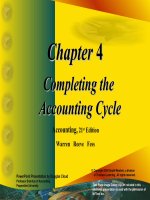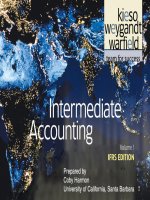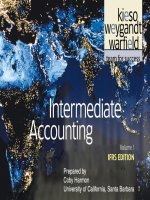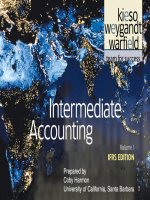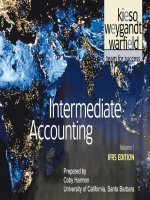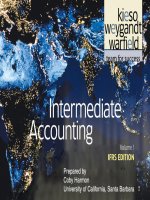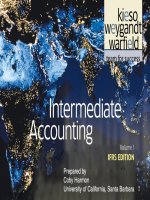Intermediate accounting volum 1 IFRS edition chapter 04
Bạn đang xem bản rút gọn của tài liệu. Xem và tải ngay bản đầy đủ của tài liệu tại đây (1.44 MB, 73 trang )
Slide
4-1
CHAPTER
4
INCOME STATEMENT AND RELATED
INFORMATION
Intermediate Accounting
IFRS Edition
Kieso, Weygandt, and Warfield
Slide
4-2
Learning
Learning Objectives
Objectives
Slide
4-3
1.
Understand the uses and limitations of an income statement.
2.
Understand the content and format of the income statement.
3.
Prepare an income statement.
4.
Explain how to report items in the income statement.
5.
Identify where to report earnings per share information.
6.
Explain intraperiod tax allocation.
7.
Understand the reporting of accounting changes and errors.
8.
Prepare a retained earnings statement.
9.
Explain how to report other comprehensive income.
Income
Income Statement
Statement and
and Related
Related Information
Information
Income Statement
Usefulness
Limitations
Quality of
Earnings
Slide
4-4
Format of Income
Statement
Reporting Within
the Income
Statement
Elements
Minimum
disclosure
Intermediate
components
Illustration
Gross profit
Income from
operations
Income before
income tax
Net income
Condensed income
statements
Non-controlling
interests
Earnings per share
Discontinued
operations
Intraperiod tax
allocation
Summary
Other Reporting
Issues
Accounting changes
and errors
Retained earnings
statement
Comprehensive
income
Changes in equity
statement
Income
Income Statement
Statement
Usefulness
Evaluate past performance.
Predicting future performance.
Help assess the risk or uncertainty
of achieving future cash flows.
Slide
4-5
LO 1 Understand the uses and limitations of an income statement.
Income
Income Statement
Statement
Limitations
Companies omit items that cannot
be measured reliably.
Income is affected by the accounting
methods employed.
Income measurement involves
judgment.
Slide
4-6
LO 1 Understand the uses and limitations of an income statement.
Income
Income Statement
Statement
Quality of Earnings
Companies have incentives to manage income to meet
or beat market expectations, so that
market price of stock increases and
value of management’s compensation increase.
Quality of earnings is reduced if earnings management
results in information that is less useful for predicting
future earnings and cash flows.
Slide
4-7
LO 1 Understand the uses and limitations of an income statement.
Format
Format of
of the
the Income
Income Statement
Statement
Elements of the Income Statement
Income – Increases in economic benefits during the accounting
period in the form of inflows or enhancements of assets or
decreases of liabilities that result in increases in equity, other
than those relating to contributions from shareholders.
Slide
4-8
LO 1 Understand the uses and limitations of an income statement.
Format
Format of
of the
the Income
Income Statement
Statement
Elements of the Income Statement
Income includes both revenues and gains.
Revenues - ordinary activities of a company
Gains - may or may not arise from ordinary activities.
Revenue Accounts
Sales
Fee revenue
Interest revenue
Dividend revenue
Gain Accounts
Gains on the sale of long-term
assets
Unrealized gains on availablefor-sale securities.
Rent revenue
Slide
4-9
LO 2 Understand the content and format of the income statement.
Format
Format of
of the
the Income
Income Statement
Statement
Elements of the Income Statement
Expenses – Decreases in economic benefits during the
accounting period in the form of outflows or depletions of assets
or incurrences of liabilities that result in decreases in equity,
other than those relating to distributions to shareholders.
Examples of Expense Accounts
Cost of goods sold
Rent expense
Depreciation expense
Salary expense
Interest expense
Slide
4-10
LO 1 Understand the uses and limitations of an income statement.
Format
Format of
of the
the Income
Income Statement
Statement
Elements of the Income Statement
Expenses includes both expenses and losses.
Expenses - ordinary activities of a company
Losses - may or may not arise from ordinary activities.
Expense Accounts
Cost of goods sold
Depreciation expense
Interest expense
Rent expense
Salary expense
Slide
4-11
Loss Accounts
Losses on restructuring
charges
Losses on to sale of long-term
assets
Unrealized losses on availablefor-sale securities.
LO 2 Understand the content and format of the income statement.
Format
Format of
of the
the Income
Income Statement
Statement
Elements of the Income Statement
IFRS requires, at a minimum, the following be presented on
the income statement.
Slide
4-12
LO 2 Understand the content and format of the income statement.
Format
Format of
of the
the Income
Income Statement
Statement
Intermediate
Components
Common for
companies to
present some or all
of these sections
and totals within the
income statement.
Slide
4-13
Illustration 4-1
Income Statement Format
LO 2
Format
Format
Illustration
Includes all of the
major items in the list
above, except for
discontinued
operations.
Slide
4-14
LO 3
Illustration 4-2
Income Statement
Format
Format of
of the
the Income
Income Statement
Statement
Condensed
More
representative
of the type
found in
practice.
Illustration 4-3
Condensed Income Statement
Slide
4-15
LO 3 Prepare an income statement.
Reporting
Reporting Within
Within the
the Income
Income Statement
Statement
Gross Profit
Computed by deducting cost of goods sold from net sales
revenue.
Disclosure of net sales revenue is useful.
Unusual or incidental revenue is disclosed in other income
and expense.
Analysts can more easily understand and assess trends in
revenue from continuing operations.
Slide
4-16
LO 4 Explain how to report items in the income statement.
Reporting
Reporting Within
Within the
the Income
Income Statement
Statement
Income from Operations
Determined by deducting selling and administrative
expenses as well as other income and expense from gross
profit.
Highlights items that affect regular business activities.
Used to predict the amount, timing, and uncertainty of
future cash flows.
Slide
4-17
LO 4 Explain how to report items in the income statement.
Reporting
Reporting Within
Within the
the Income
Income Statement
Statement
Income from Operations
Expense Classification
Reported by
Nature, or
Function
Slide
4-18
LO 4 Explain how to report items in the income statement.
Reporting
Reporting Within
Within the
the Income
Income Statement
Statement
Expense Classification
Illustration: Assume that the accounting firm of Telaris Co.
provides audit, tax, and consulting services. It has the
following revenues and expenses.
Slide
4-19
LO 4 Explain how to report items in the income statement.
Reporting
Reporting Within
Within the
the Income
Income Statement
Statement
Expense Classification (Nature-of-Expense Approach)
Illustration 4-5
Slide
4-20
LO 4 Explain how to report items in the income statement.
Reporting
Reporting Within
Within the
the Income
Income Statement
Statement
Expense Classification (Function-of-Expense Approach)
Illustration 4-6
The function-of-expense method is generally used in practice although many
companies believe both approaches have merit.
Slide
4-21
LO 4 Explain how to report items in the income statement.
Reporting
Reporting Within
Within the
the Income
Income Statement
Statement
Gains and Losses
Slide
4-22
Illustration 4-7
Number of Unusual Items
Reported in a Recent Year
by 600 Large Companies
LO 4 Explain how to report items in the income statement.
Reporting
Reporting Within
Within the
the Income
Income Statement
Statement
Gains and Losses
IASB takes the position that both
revenues and expenses and
other income and expense
should be reported as part of income from operations.
Companies can provide additional line items, headings, and subtotals when
such presentation is relevant to an understanding of the entity’s financial
performance.
Slide
4-23
LO 4 Explain how to report items in the income statement.
Reporting
Reporting Within
Within the
the Income
Income Statement
Statement
Gains and Losses
Additional items that may need disclosure:
Slide
4-24
Losses on write-downs of inventories to net realizable value or of
property, plant, and equipment to recoverable amount, as well as
reversals of such write-downs.
Losses on restructurings of the activities and reversals of any
provisions for the costs of restructuring.
Gains or losses on the disposal of items of property, plant, and,
equipment or investments.
Litigation settlements.
Other reversals of liabilities.
LO 4 Explain how to report items in the income statement.
Reporting
Reporting Within
Within the
the Income
Income Statement
Statement
Income before Income Tax
Financing costs must be reported on the income statement.
Illustration 4-8
Slide
4-25
LO 4 Explain how to report items in the income statement.

